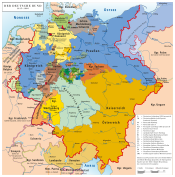Duchy of Limburg
Duchy of Limburg | |||||||
|---|---|---|---|---|---|---|---|
| 1065–1794 | |||||||
 The duchy of Limburg and the Prince-Bishopric of Liège (1477) | |||||||
| Status | State of the Holy Roman Empire | ||||||
| Capital | Limbourg | ||||||
| Common languages | French, Dutch, German, Walloon | ||||||
| Religion | Roman Catholicism | ||||||
| Government | Monarchy | ||||||
| Duke | |||||||
| Waleran I, Count of Limburg | |||||||
| Henry I, Duke of Limburg and Lower Lorraine | |||||||
| John I, Duke of Brabant, Limburg and Lothier | |||||||
| Philip III, Duke of Burgundy, King of Castile–León etc | |||||||
| Francis I, Duke of Lorraine, Holy Roman Emperor etc | |||||||
| Historical era | Middle Ages | ||||||
• Established | 1065 | ||||||
| June 5 1288 | |||||||
| 1406 | |||||||
• Peace of Westphalia | 1648 | ||||||
| 1713 | |||||||
| 1794 | |||||||
| |||||||
- This article deals with the historical duchy of Limburg, for other meanings see Limburg.
The Duchy of Limburg was an historical region in the Low Countries. It consisted of parts of the present Belgian provinces Liège (northeastern part) and Limburg (a.o. Voeren, Rekem), the Dutch province of Limburg (southern part), and a small part of North Rhine-Westphalia in Germany (a.o. Herzogenrath).
In Roman times, Limburg was situated in the Roman provinces of Germania Inferior and inhabited by Celtic tribes, until Germanic peoples replaced them and made an end to roman imperial rule.
Its most important cities were Maastricht, Verviers and Eupen.
Today the historic Duchy of Limburg is territorially divided up between Belgium, the Netherlands and Germany.
History
The Duchy of Limburg, situated in the Low Countries between the river Meuse and the city of Aachen, was a state of the Holy Roman Empire and the German Confederation. Its territory is presently divided between the Belgian provinces of Liège and Limburg (Voeren) and the Dutch province of Limburg.
The duchy was formed in the 11th century around the town of Limbourg in present-day Belgium. After Irmgard, last Duchess of Limburg, died childless in 1283, a war of succession broke out. The Duke of Brabant won the Battle of Worringen in 1288, thereby gaining control of the Duchy of Limburg. Limburg remained a separate entity both under the rule of Burgundy after 1430 and that of the Habsburgs after 1477. Combined with the Landen van Overmaas (the lands across the Meuse: Dalhem, Rolduc and Valkenburg), it was one of the Seventeen Provinces. Significant towns in Limburg proper were Herve, Montzen, Lontzen, Eupen, Baelen and Esneux.
At the Peace of Westphalia which ended the Eighty Years' War in 1648, an area known as Staats-Limburg and consisting of parts of Limburg and Overmaas was ceded to the United Provinces. The remainder of the duchy (including Limburg proper) remained under Spanish rule as part of the Southern Netherlands, passing to Austrian rule under the Treaty of Utrecht in 1713.
When the region was occupied by the French in 1794, Staats-Limburg became part of the département of Meuse-Inférieure.
The Austrian duchy of Limburg was disbanded and became part of the département of Ourte. Following the defeat of Napoleon in 1814, the area of the former duchy was united within the United Kingdom of the Netherlands (what is now Belgium, Luxembourg and the Netherlands) and Meuse-Inférieure and Ourte respectively formed the new Province of Limburg and Province of Liège. This Province of Limburg covered an area much larger than and somewhat different from the former duchy with Limburg's namesake town of Limbourg located in Liège.
When the Catholic and French-speaking Belgians split away from the mainly Calvinist, Dutch Netherlands in the Belgian Revolution of 1830, the Province of Limburg was at first almost entirely under Belgian rule. However, by the 1839 Treaty of London, the province was divided in two, with the eastern part going to the Netherlands and the western part to Belgium, a division that remains today.
With the Treaty of London, what is now the Belgian Province of Luxembourg was handed over to Belgium and removed from the German Confederation. To appease Prussia, which had also lost access to the Meuse after the Congress of Vienna, the Dutch province of Limburg (but not the cities of Maastricht and Venlo), was a joined to the German Confederation between 1839 and 1866 as the Duchy of Limburg, while remaining an integral part of the Dutch territory. The province used the title of "duchy" until 1906.



